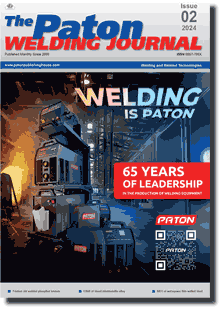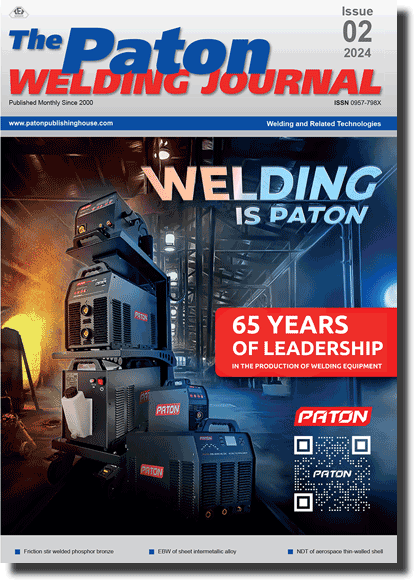| 2024 №02 (07) |
DOI of Article 10.37434/tpwj2024.02.01 |
2024 №02 (02) |

The Paton Welding Journal, 2024, #2, 3-7 pages
Microhardness and corrosion properties of friction stir welded phosphor bronze
S. Gopi1, D.G. Mohan2
1Department of Production Engineering, Government College of Technology Coimbatore, Tamilnadu, India, 6410132School of Engineering Faculty of Technology, University of Sunderland England, United Kingdom - SR6 0DD. E-mail: dhanesh.mohan@sunderland.ac.uk
Abstract
This study investigates the microhardness and corrosion properties of friction stir welded (FSW) joints in phosphor bronze (CuSn4), a vital non-ferrous alloy in engineering applications. The research delves into the FSW process, employing varying welding parameters to create joints that exhibit distinct microstructural characteristics. Microhardness distribution across the FSW joints is assessed and correlated with the base material’s properties. Corrosion behaviour is rigorously examined through weight loss tests, revealing insights into the susceptibility of FSW joints to various corrosive environments. The study identifies the influence of FSW parameters on microhardness and corrosion performance, thus contributing to understanding the alloy’s behaviour under this welding technique. This research shows that the welding speed of 0.25 mm/s, tool rotational speed of 1100 rpm, plunger depth of 0.2 mm, and a hexagonal tool profile produce the better joint with the highest microhardness of 139 HV and rate of corrosion of 0.420831 %.
Keywords: friction stir welding, phosphor bronze, corrosion, microhardness, joining
Received: 23.08.2023
Received in revised form: 26.12.2023
Accepted: 31.01.2024
References
1. Hu, D., Chen, M., Wang, L. et. al. (2016) Dynamic tensile behaviour and deformational mechanism of C5191 phosphor bronze under high strain rates deformation. Materials Sci. and Eng.: A, 649, 68-73. https://doi.org10.1016/j.msea.2015.09.0752. Khan, N.Z., Siddiquee, A.N., Khan, Z.A. et. al. (2021) Improvement in joint efficiency with high productivity and narrow weld formation in friction stir welding. Proceedings of the Institution of Mechanical Engineers, Pt E. J. of Process Mechanical Eng., 095440892110424. https://doi.org10.1177/09544089211042480
3. Zoeram, A.S., Anijdan, S.H.M., Jafarian, H.R. et. al. (2017) Welding parameters analysis and microstructural evolution of dissimilar joints in al/bronze processed by friction stir welding and their effect on engineering tensile behavior. Materials Sci. and Eng.: A, 687, 288-297. https://doi.org10.1016/j.msea.2017.01.071
4. Mohan, D.G., Wu, C. (2021) A review on friction stir welding of steels. Chinese J. of Mechanical Eng., 34(1). https://doi.org10.1186/s10033-021-00655-3
5. Rabiezadeh, A., Salafzon, A., Mostafavi, N. (2023) Dissimilar welding of AA5083/AA7039 by self-reacting friction stir welding. J. of Adhesion Sci. and Technology, 1-22. https://doi.org10.1080/01694243.2023.2219367
6. Sasikumar, A., Gopi, S., Mohan, D.G. (2022) Prediction of filler added friction stir welding parameters for improving corrosion resistance of dissimilar aluminium alloys 5052 and 6082 joints. Advances in Materials Sci., 22(3), 79-95. https://doi.org10.2478/adms-2022-0014
7. Yin, K., Cao, L., Wang, N. (2019) Mechanical properties and residual stresses of 5083 to AM60B dissimilar friction stir welding with different process parameters. J. of Adhesion Sci. and Technology, 33(23), 2615-2629. https://doi.org10.1080/01694243.2019.1653593
8. Çam, G. (2011) Friction stir welded structural materials: Beyond al-alloys. Inter. Materials Reviews, 56(1), 1-48. https://doi.org10.1179/095066010X12777205875750
9. Shokri, V., Sadeghi, A., Sadeghi, M. H. (2017) Effect of friction stir welding parameters on microstructure and mechanical properties of DSS-cu joints. Materials Sci. and Eng.: A, 693, 111-120. https://doi.org10.1016/j.msea.2017.03.054
10. Liu, H. J., Shen, J. J., Zhou, L., et. al. (2011) Microstructural characterisation and mechanical properties of friction stir welded joints of aluminium alloy to copper. Sci. and Technology of Welding and Joining, 16(1), 92-98. https://doi.org10.1179/1362171810Y.0000000007
11. Vinith, B., Dharshan, S. A., Aravind, S. et. al. (2023) Friction stir welding evolution, hybrid technologies and shoulder shape. Inter. J. on Interactive Design and Manufacturing, 17(4), 1443-1458. https://doi.org10.1007/s12008-023-01208-9
12. Mohan, D. G., Tomków, J., Gopi, S. (2021). Induction assisted hybrid friction stir welding of dissimilar materials AA5052 aluminium alloy and X12Cr13 stainless steel. Advances in Materials Sci., 21(3), 17-30. https://doi.org10.2478/adms-2021-0015
13. Wang, Q., Zhou, X., Wang, B. et. al. (2023) Accelerated role of exogenous riboflavin in Selective desulfovibrio desulfuricans corrosion of pipeline welded joints. Bioelectrochemistry, 153, 108469. https://doi.org10.1016/j.bioelechem.2023.108469
14. Liu, P., Li, Y., Geng, H. et. al. (2007) Microstructure characteristics in TIG welded joint of Mg/Al dissimilar materials. Materials Letters, 61(6), 1288-1291. https://doi.org10.1016/j.matlet.2006.07.010
15. Gopi, S., Mohan, D.G. (2021) Evaluating the welding pulses of various tool profiles in single-pass friction stir welding of 6082-T6 aluminium alloy. J. of Welding and Joining, 39(3), 284-294. https://doi.org10.5781/JWJ.2021.39.3.7
16. Yelamasetti, Balrm, Adithya, G.S., Ramadevi, R.S. et. al. (2023) Metallurgical, mechanical and corrosion behaviour of pulsed and constant current TIG dissimilar welds of Aisi 430 and Inconel 718. J. of Materials Research and Technology, 24, 6652-6664. https://doi.org10.1016/j.jmrt.2023.04.231
17. Tamadon, A., Pons, D.J., Clucas, D. (2020) Analogue modelling of flow patterns in bobbin friction stir welding by the dark-field/bright-field illumination method. Advances in Materials Sci., 20(1), 56-70. https://doi.org10.2478/adms-2020-0003
18. Yelamasetti, Balram, Vardhan, T.V., Ramana, G.V. (2020) Study of metallurgical changes and mechanical properties of dissimilar weldments developed by interpulse current TIG welding technique. Proceedings of the Institution of Mechanical Engineers, Pt C: J. of Mechanical Eng. Sci., 235(16), 2985-2997. https://doi.org10.1177/0954406220960780
19. Xuan, Y., Yang, J., Liu, H. et. al. (2020) Microstructure and mechanical properties of Invar36 alloy joints using keyhole TIG welding. Sci. and Technology of Welding and Joining, 25(8), 712-718. https://doi.org10.1080/13621718.2020.1830545
20. Dhondt, M., Aubert, I., Saintier, N. et. al. (2011) Intergranular stress corrosion cracking of friction stir welded nugget on a 2050-T8 aluminum alloy. Advances in Materials Sci., 11(3). https://doi.org10.2478/v10077-011-0016-6
21. Kusano, K., Watanabe, H. (2002) Recent trends in development of high-efficiency TIG welding; high-deposition TIG welding and ultranarrow-gap TIG welding. Welding Inter., 16(12), 986-991. https://doi.org10.1080/09507110209549651
22. Dudzik, K., Jurczak, W. (2015) Influence of friction stir welding on corrosion properties of AW-7020M alloy in sea water. Advances in Materials Sci., 15(1), 7-13. https://doi.org10.1515/adms-2015-0002
23. Zhou, D., Xia, Y., Gao, Z. et. al. (2023) Effect of loading conditions on corrosion fatigue process of FSW AA6061-T6 joint in 3.5 % NaCl studied by electrochemical noise. J. of Materials Research and Technology, 24, 9808-9823. https://doi.org10.1016/j.jmrt.2023.05.179
24. Qiu, Y., Yang, X., Xu, J. et. al. (2022) Enhanced mechanical property and corrosion resistance of alloy 5182 fsw joints by SC and ZR alloying. Materials Characterization, 194, 112412. https://doi.org10.1016/j.matchar.2022.112412
Suggested Citation
S. Gopi, D.G. Mohan (2024) Microhardness and corrosion properties of friction stir welded phosphor bronze. The Paton Welding J., 02, 3-7.The cost of subscription/purchase order journals or individual articles
| Journal/Currency | Annual Set | 1 issue printed |
1 issue |
one article |
| TPWJ/USD | 384 $ | 32 $ | 26 $ | 13 $ |
| TPWJ/EUR | 348 € | 29 € | 24 € | 12 € |
| TPWJ/UAH | 7200 UAH | 600 UAH | 600 UAH | 280 UAH |
| AS/UAH | 1800 UAH | 300 UAH | 300 UAH | 150 UAH |
| AS/USD | 192 $ | 32 $ | 26 $ | 13 $ |
| AS/EUR | 180 € | 30 € | 25 € | 12 € |
| SEM/UAH | 1200 UAH | 300 UAH | 300 UAH | 150 UAH |
| SEM/USD | 128 $ | 32 $ | 26 $ | 13 $ |
| SEM/EUR | 120 € | 30 € | 25 € | 12 € |
| TDNK/UAH | 1200 UAH | 300 UAH | 300 UAH | 150 UAH |
| TDNK/USD | 128 $ | 32 $ | 26 $ | 13 $ |
| TDNK/EUR | 120 € | 30 € | 25 € | 15 € |
AS = «Automatic Welding» - 6 issues per year;
TPWJ = «PATON WELDING JOURNAL» - 12 issues per year;
SEM = «Electrometallurgy Today» - 4 issues per year;
TDNK = «Technical Diagnostics and Non-Destructive Testing» - 4 issues per year.


